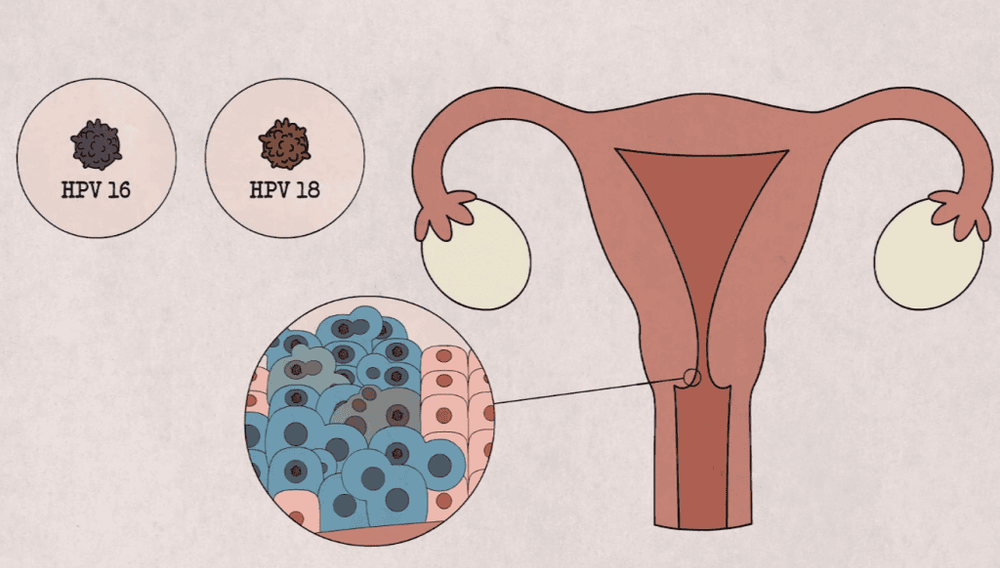This is an automatically translated article.
Cervical cancer is one of the leading causes of death in women. The disease often has a rather complicated course, if not detected and treated in time, cancer can spread to other parts of the body, making treatment extremely difficult.
1. What is cervical cancer?
Cervical cancer usually starts in the cells lining the cervix – the lower part of the uterus (womb). In the human body, a woman's cervix connects the body of the uterus (the upper part where the fetus develops) to the vagina (the birth canal). They are made up of 2 parts and are covered by two different types of cells:
Inside the cervix (cervical canals): covered by glandular cells. Outside of the cervix: covered by squamous cells. The place where these two types of cells meet in the cervix is called the transformation zone. The exact location of the transformation zone can change after childbirth and as you age. Most cervical cancers start from cells in the mutated area that grow out of control.

Ung thư cổ tử cung thường bắt đầu từ các tế bào lót của cổ tử cung – phần dưới của tử cung (dạ con)
2. Stages of cervical cancer
After a patient is diagnosed with cervical cancer, the doctor will assess whether it has spread, and if so, how far. This process is called phase. Cervical cancer stages describe how far the cancer has spread in the body. In addition, it also helps to determine the severity of the disease, thereby making the best treatment options for the patient. It can be said that stage is one of the most important factors in deciding how to treat cancer and evaluating the success of treatment.
To determine the stage of cervical cancer after diagnosis, specialists will find out:
How far has the cancer spread to the cervix? Has the cancer spread to nearby structures? Has the cancer spread to nearby lymph nodes or to other distant organs in the body? The results of these exams and tests will help your doctor determine the size and depth of tumors that have invaded the tissues in and around the cervix, as well as whether they have spread to other organs. elsewhere in the body.
Currently, the FIGO (International Federation of Gynecology and Obstetrics) classification system has been widely applied to cancers of the female reproductive organs, including cervical cancer. . For women with cervical cancer, the clinical stage will be used and is based on the results of a physical exam, biopsies, imaging tests, and certain other tests performed under certain circumstances. , such as cystoscopy and colposcopy . Clinical staging is not usually based on findings during surgery. If surgery is performed, a pathological stage can be determined from the operative findings, but it does not alter the clinical stage of the patient. In addition, the patient's treatment plan will be based on the clinical stage.

Các giai đoạn ung thư cổ tử cung sẽ mô tả mức độ lan rộng của ung thư trong cơ thể
Cervical cancer has 4 different stages (from I-IV). As a rule, the lower the number, the less likely the cancer will metastasize. When the cancer enters stage IV, it means that cervical cancer has progressed more seriously. And in a particular stage is divided into several lower stages, indicated by the inclusion of a letter (from A-D).
Here are the specific characteristics of each stage of cervical cancer as classified by FIGO:
Stage I: cancer cells have grown from the surface of the cervix into the deeper tissues of the cervix. Cervical. At this point, the cancer has not spread to nearby lymph nodes and other distant sites in the body.
Stage IA: there is a very small amount of cancer and can only be seen under a microscope. Stage IA1: The cancer can only be seen with a microscope and is less than 3mm (about 1/8 inch) deep. Stage IA2: The cancer can only be seen with a microscope and is 3mm to 5mm deep (about 1/5 of an inch). Stage IB: Stage I cancer has spread more than 5mm (about 1/5 inch) deep but is still limited to the cervix. Stage IB1: The cancer is deeper than 5mm (about 1/5 inch) but no more than 2cm (about 4/5 inch) in size. Stage IB2: The cancer is at least 2cm in size but not larger than 4cm. Stage IB3: The cancer is at least 4cm in size and limited to the cervix. Stage II: The cancer has grown beyond the cervix and uterus, but has not spread to the pelvis or lower part of the vagina. It has also not spread to nearby lymph nodes and other distant areas in the body.
Stage IIA: cancer has grown outside of the cervix and uterus but has not spread into tissues next to the cervix (called glandular tissue). Stage IIA1: the cancer is not larger than 4 cm. Stage IIA2: The cancer is larger or equal to 4 cm. Stage IIB: The cancer has grown outside of the cervix and uterus and has spread into the tissues next to the cervix.

Ung thư cổ tử cung là một trong những nguyên nhân hàng đầu gây tử vong ở nữ giới
Stage III: Cancer has spread to the lower part of the vagina or the pelvic wall. At this point, the cancer can block the ureter (the tube that carries urine from the kidney to the bladder). Additionally, they may/may not have spread to nearby lymph nodes, nor have they spread to other distant sites.
Stage IIIA: Cancer has spread to the lower part of the vagina but has not spread to the pelvic walls. It has also not spread to nearby lymph nodes and other distant areas. Stage IIIB: The cancer has grown into the wall of the pelvis and is blocking one or two ureters, causing problems with the body, such as hydronephrosis. However, it has not spread to nearby lymph nodes and other distant areas. Stage IIIC: The cancer can be any size. Imaging tests or biopsies show that the cancer has spread to nearby pelvic lymph nodes (IIIC1), or para-aortic lymph nodes (IIIC2). However, at this time the cancer has not spread to distant sites in the body. Stage IV: Cancer has grown into the bladder, rectum, or to other distant organs such as the lungs and bones.
Stage IVA: cancer has spread to the bladder or rectum, or it is growing outside the pelvis. Stage IVB: The cancer has spread to distant organs outside the pelvis, such as distant lymph nodes, lungs, or bones. In order to help customers detect and treat gynecological diseases early, Vinmec International General Hospital has a basic gynecological examination and screening package, which helps customers detect early infectious diseases and help treat easy, inexpensive. Screening detects gynecological cancer (cervical cancer) early even when there are no symptoms.
Basic gynecological examination and screening package for female customers, has no age limit and may have the following symptoms:
Abnormal vaginal bleeding Menstrual problems: irregular menstrual cycle, irregular menstrual cycle Abnormal vaginal discharge (smell, different color) Vaginal pain and itching Female clients have several risk factors such as poor personal hygiene, Unsafe sex, abortion, ... Female customers have other symptoms such as: Abnormal vaginal discharge, itching, pain in the intimate area, abnormal vaginal bleeding.
Please dial HOTLINE for more information or register for an appointment HERE. Download MyVinmec app to make appointments faster and to manage your bookings easily.
References: Cancer.org
MORE:
Cervical Cancer Stages Causes, risk factors and ways to prevent cervical cancer Early detection, diagnosis and staging of cervical cancer uterus













